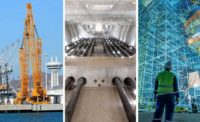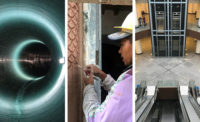Antarctic researchers spend months in total darkness and brave -55°C temperatures and winds in excess of 100 mph. Yet these hardy souls endure and thrive at the Halley VI Antarctic Research Station, a $42-million habitat constructed in one of the most hostile environments on Earth.
The sixth station to be built, since it began research in 1956, by British Antarctic Survey (BAS), Halley VI confronts the harsh conditions through an innovative design, the use of building components borrowed from other industries, and meticulous planning and prefabrication. Still, from conception to completion, the project took nearly a decade, due to an extremely short building season and limited accessibility.
"There's an old adage: A month spent properly planning a project will save you a year at the end of the project. In Antarctica, that's absolutely true," says John Hammerton, operations director with Galliford Try, the Uxbridge, England-based contractor tasked with building the 1,510-sq-meter station. "You have to put all your effort into the front-end planning and design and get that right."
To that end, BAS launched the project, in 2004, through an international design competition to find a fresh approach to station design through technological innovation and creativity, says Linda Capper, BAS director of communications. The competition drew 86 entries from around the world. "We expected to get a lot of interest, but the quality and variety of ideas that came forward through the first phase was astonishing. The competition clearly fired the imagination [of designers]," she adds.
After a year-long evaluation period—which included fully funding three finalists to travel to Antarctica and finalize their schemes—BAS awarded the design to a partnership between the London offices of AECOM and Hugh Broughton Architects.
"It was the most rigorous design competition you could ever imagine," says Peter Ayres, AECOM's project director.
Located atop the 150-m-thick Brunt Ice Shelf, the station needed to respond to the area's copious snowfall of up to 1.5 m per year. All the structures—the seven 152-sq-m, blue-clad modules, which house the bedrooms, generating plants and science labs, and the 479-sq-m, red-clad module for dining and socializing—stay above the ever-rising snow by perching on 4-m-high, 580-millimeter-dia stilted legs.
The modules stand in a line as if they were train cars and are linked to each other with flexible inter-carriage connectors, modified, in fact, from the rail industry. Orienting the 188-m-long linear "train" perpendicular to the prevailing winds keeps the blowing snow from collecting underneath the aerodynamic structures, says Michael Wright, lead engineer with AECOM. At the end of each winter season, the modules lie deep within a scoop-shaped trough.
But Halley VI has another trick up its sleeve to rise above the trough before the snowbanks get too deep: At the press of a button, a technician can raise, one at a time, each module's four circular, telescopic leg tubes via an integral hydraulic ram. A Caterpillar D5 bulldozer operator pushes and compacts the snow to create a new, higher base for the leg, which is lowered back down to meet the new surface. Once all the legs are lifted, the entire station is jacked up to its full height.
The previous station also was built on stilts that could be jacked up, but the process took two months and required a team of ironworkers to reweld the legs, once extended. "It was very expensive, not just to send people down but to accommodate them through the summer season," Ayres says. The new base takes just six days to raise using on-site staff.
But the cause of the previous station's failure wasn't the snow but its fixed foundation. Just like a glacier, the ice shelf travels up to 1,300 ft toward the sea every year, and Halley V eventually crept too close to the calving edge. To overcome this hurdle, Halley VI's legs are affixed with skis. When the base is in danger, modules detach and are pulled by bulldozers to a safe site, where the modules can be reattached.















Post a comment to this article
Report Abusive Comment